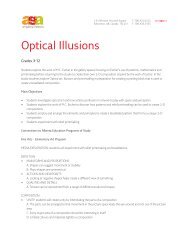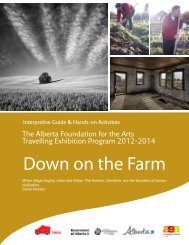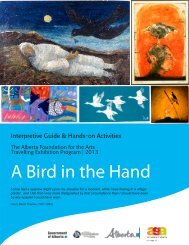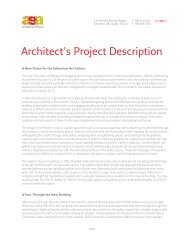Urban Animals - Art Gallery of Alberta
Urban Animals - Art Gallery of Alberta
Urban Animals - Art Gallery of Alberta
Create successful ePaper yourself
Turn your PDF publications into a flip-book with our unique Google optimized e-Paper software.
The <strong>Alberta</strong> Foundation for the <strong>Art</strong>s Travelling Exhibition Program<br />
Reading Pictures Program continued<br />
<strong>Art</strong> is all around us and we are all involved in artistic endeavors to some degree. The<br />
photographs we take, the colour and styles <strong>of</strong> the clothes we wear, the ways we build and<br />
decorate our homes, gardens and public buildings, the style <strong>of</strong> our cell phones or the vehicles<br />
we drive, the images we see and are attracted to in advertising or the text or symbols on our<br />
bumper stickers – all <strong>of</strong> these things (and 9 billion others) utilize artistic principles. They say<br />
something about our personal selves and reflect upon and influence the economic, political,<br />
cultural, historical and geographic concerns <strong>of</strong> our society.<br />
<strong>Art</strong>, therefore, is not just something some people in a society do – it is something that affects<br />
and informs everyone within a society.<br />
Today we’re going to look at art - paintings, prints, drawings, sculptures – and see what art can<br />
tell us about the world we live in – both the past, the present and possibly the future – and what<br />
art can tell us about ourselves.<br />
<strong>Art</strong> is a language like any other and it can be read.<br />
<strong>Art</strong> can be read in two ways. It can be looked at intuitively – what do you see? What do you like<br />
or not like? How does it make you feel and why? – or it can be read formally by looking at what<br />
are called the Elements <strong>of</strong> Design – the tools artists use or consider when creating a piece <strong>of</strong><br />
work.<br />
What do you think is meant by the elements <strong>of</strong> design? What does an artist use to create a work<br />
<strong>of</strong> art?<br />
Today we’re going to examine how to read art – we’re going to see how art can affect us<br />
emotionally... and how an artist can inform us about our world, and ourselves, through what he<br />
or she creates.<br />
Tour Program:<br />
–Proceed to one <strong>of</strong> the works in the exhibition and discuss the following:<br />
a) The nature <strong>of</strong> the work - what kind <strong>of</strong> work is it and what exhibition is it a part <strong>of</strong>?<br />
b) Examine the work itself – What do visitors see?<br />
– How do you initially feel about what you see? Why do you feel<br />
this way? What do you like? What don’t you like? Why?<br />
–What is the work made <strong>of</strong>?<br />
–How would you describe the style? What does this mean?<br />
AFA Travelling Exhibition Program, Edmonton, AB. Ph: 780.428.3830 Fax: 780.421.0479<br />
youraga.ca

















